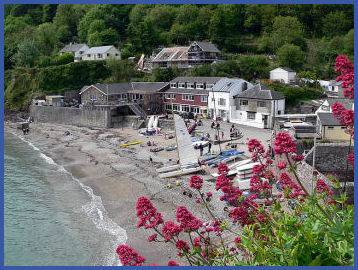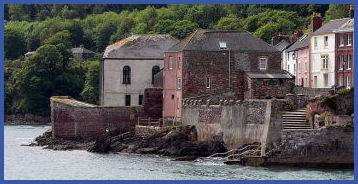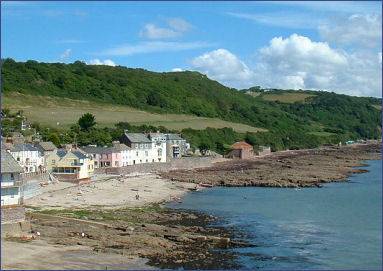Kingsand and Cawsand
OS Grid ref:- SX 435 504
 The highly attractive adjoining small fishing villages of Kingsand and Cawsand lie on the Rame Peninsula and are known as
"Cornwall 's Forgotten Corner". The villages date mainly from the seventeenth century and lie sheltered by a wooded headland at the mouth of Plymouth Sound, the bay is flanked to the south by the wooded slopes of Penlee whilst on the northern side is the more open parkland of Mount Edgcumbe Country Park. The villages are only a short walk apart and the surrounding scenery is spectacular.
The highly attractive adjoining small fishing villages of Kingsand and Cawsand lie on the Rame Peninsula and are known as
"Cornwall 's Forgotten Corner". The villages date mainly from the seventeenth century and lie sheltered by a wooded headland at the mouth of Plymouth Sound, the bay is flanked to the south by the wooded slopes of Penlee whilst on the northern side is the more open parkland of Mount Edgcumbe Country Park. The villages are only a short walk apart and the surrounding scenery is spectacular.
The beaches, which are rarely crowded and face east into Plymouth Sound, are both sand and shingle. Kingsand beach is separated into two by rocks. There are rock pools to explore at Kingsand and access to both Kingsand beaches are via slopes and a few steps. The beaches are safe for swimming. Sailing; windsurfing, water-skiing and fishing are also available. Dogs allowed all year at Kingsand Beach. Dogs are banned at Cawsand Beach from Easter Day to October 1. To the north of Kingsand there is a small sandy beach called Sandway Cellar, which is accessible via a 10 minute walk along the rocky foreshore or via the coast path. During the Summer months, the Cawsand Ferry to Plymouth Barbican is available every hour and a half.
 The name Kingsand was first used in the mid sixteenth century. It is thought to be English in origin, rather than Cornish, and derives from the fact that the sands were owned by a family called King. The first recorded mention of the name of Cawsand, was as Couyssond in the early fifteenth century. The name, which is also believed to be English, derives from the words 'cow' and 'sand'. The dividing line between the two villages was at one time the boundary between the counties of Devon and Cornwall and there still exists a house called Devon Corn which displays the marker on the front of it.
The name Kingsand was first used in the mid sixteenth century. It is thought to be English in origin, rather than Cornish, and derives from the fact that the sands were owned by a family called King. The first recorded mention of the name of Cawsand, was as Couyssond in the early fifteenth century. The name, which is also believed to be English, derives from the words 'cow' and 'sand'. The dividing line between the two villages was at one time the boundary between the counties of Devon and Cornwall and there still exists a house called Devon Corn which displays the marker on the front of it.
 The narrow village streets are highly characterful
with their colour washed old cottages. Kingsand and Cawsand are frequent winners of the Best Kept Village award . The Clocktower on Kingsand seafront was erected to commemorate the coronation of King George V.
The attached building, referred to locally as the Institute, serves as a community hall. The Institute also contains a large crossstitch tapestry picture of the two villages, made by residents to commemorate the Queen's Golden Jubilee.
The narrow village streets are highly characterful
with their colour washed old cottages. Kingsand and Cawsand are frequent winners of the Best Kept Village award . The Clocktower on Kingsand seafront was erected to commemorate the coronation of King George V.
The attached building, referred to locally as the Institute, serves as a community hall. The Institute also contains a large crossstitch tapestry picture of the two villages, made by residents to commemorate the Queen's Golden Jubilee.
The villages offer a range of facilities, including a range of accomodation, cafes, essential shops, a post office and no fewer than five pubs.
Kingsand and Cawsand have a long history of smuggling, and in the eighteenth and early nineteenth centuries were the main centre of smuggling in the West country. Although the known smuggling tunnels have been sealed up, there are still old fish cellars and boat stores to be seen along the coastline. In the summer months, the Weston Maid passenger ferry runs between Cawsand Beach and theMayflower Steps at Plymouth. Parts of both Kingsand and Cawsand are designated Conservation Areas.